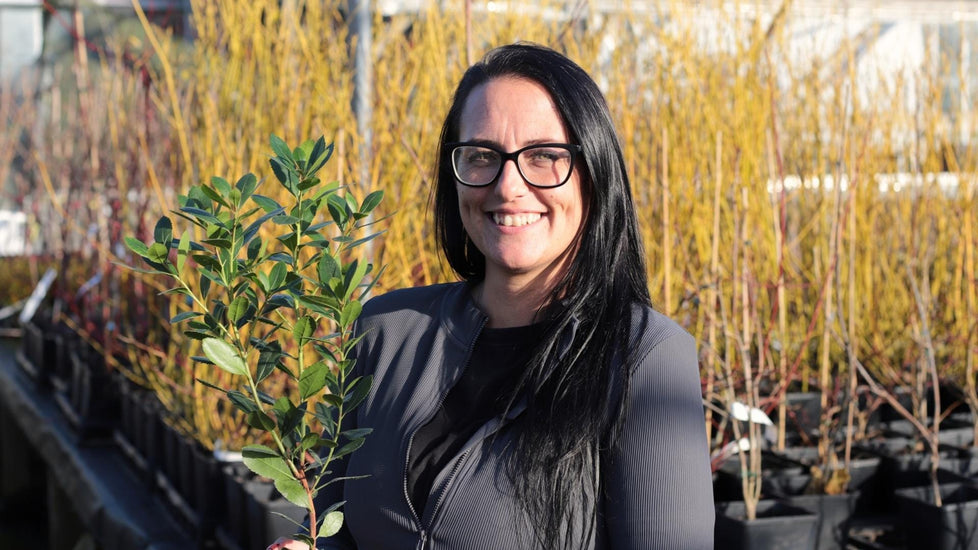Rhubarb Plants
Rhubarb is one of the earliest fruits of the year - which is pretty good going for something that's officially a vegetable! All of ours are specially selected by our Hampshire growers for taste, performance and suitability for the UK climate, wherever you live! Grow your own rhubarb plants or rhubarb crowns and you'll be harvesting crunchy and delicious stalks as early as April. They’ll go on producing stalks for at least ten years - that's a lot of crumble!
Need help picking?Sort and filter
South Downs National Park
Meet Danielle
110 years' expertise free with every plant
You simply can’t buy better fruit plants and here’s why. Danielle grows them outdoors, just like our nursery has done since 1908, so they’re more than a match for the UK weather. Danielle only has time for the top performing varieties, meaning that you can be assured of a successful (and blooming tasty) soft fruit crop.
Need help picking?
Rhubarb FAQs
What is the best time to plant rhubarb in the UK?
The best time to plant rhubarb crowns is late autumn or early winter while they’re dormant, but early spring is also fine.
What type of soil does rhubarb prefer?
Rhubarb prefers a slightly acidic to neutral soil (pH 6.0-7.0) but will grow in most garden soils as long as they’re fertile and well drained. If your soil is a bit on the dry or heavy side, you can mix in well rotted manure or compost to improve it.
How much sunlight does rhubarb need?
Rhubarb grows best in full sun (6-8 hours of sunlight daily) but it will also be happy and productive in partial shade.
How should I space rhubarb plants?
If you’re planting more than one rhubarb crown, leave about a metre between them, as they can spread quite far once they get going!
How do I plant rhubarb crowns?
To plant your rhubarb crown, dig a hole big enough for the roots to spread out, position the crown in the centre and fill in the soil so the top of the crown is about 2.5cm below the soil surface. Firm it in gently and give your rhubarb crown a good watering.
How often should I water rhubarb?
Water your rhubarb regularly when it’s newly planted, then during hot and dry weather. Be careful to avoid waterlogging, as this can lead to the crown rotting.
What type of fertiliser is best for rhubarb?
The traditional fertiliser for rhubarb is well rotted manure and plenty of it! Lay a good amount around the base of the plant in spring. Alternatively you can use a general purpose plant food, but avoid any that are high in nitrogen, as it promotes leaf growth over stalk production.
When can I start harvesting rhubarb?
Tempting as it is, don’t pick any stalks in the first year, as the plant needs to establish itself first. Start picking from year two, but sparingly. In the third year you can really go for it. Harvest the stalks when they’re about 30cm long, pulling and twisting from the base rather than cutting.
Can I force rhubarb for an earlier harvest?
Forced rhubarb (growing in the dark) produces an earlier crop which tastes sweeter and is more tender. You can do this by covering the crowns with a pot or bucket in late winter. For full instructions, read our guide to forcing rhubarb.
How do I care for rhubarb in winter?
In winter, cut back any dead or dying foliage after the first frost, then mulch around the plant with more manure or compost to protect the crown from the cold.
How long does a rhubarb plant last?
With plenty of TLC, your rhubarb plant should be productive for 10-15 years or more. You can give them an energy boost every 5-6 years by dividing the crowns (digging them up, splitting them and replanting each piece in its own space).
Can I grow rhubarb in containers?
Many varieties of rhubarb are suitable for growing in containers. Choose a very large pot with drainage holes, deep and wide enough to allow the roots to spread out. Fill your pot with high quality compost and water your rhubarb regularly.








